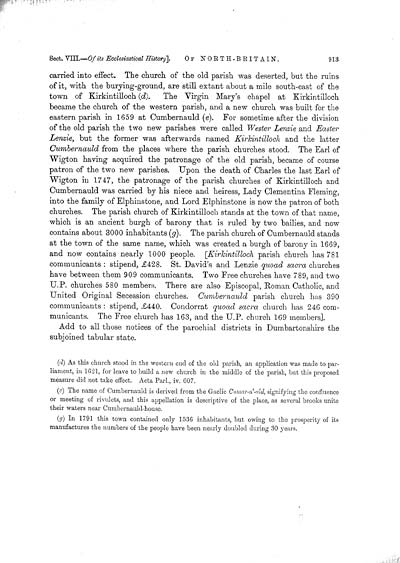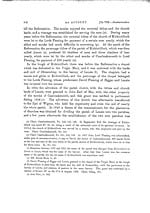Volume 6
(474) Page 913
Download files
Individual page:
Thumbnail gallery: Grid view | List view

913 carried into effect. The church of the old parish was deserted, but the ruins of it, with the burying-ground, are still extant about a mile south-east of the town of Kirkintilloch (d). The Virgin Mary's chapel at Kirkintilloch became the church of the western parish, and a new church was built for the eastern parish in 1659 at Cumbernauld (e). For sometime after the division of the old parish the two new parishes were called Wester Lenzie and Easter Lenzie, but the former was afterwards named Kirkintilloch and the latter Cumbernauld from the places where the parish churches stood. The Earl of Wigton having acquired the patronage of the old parish, became of course patron of the two new parishes. Upon the death of Charles the last Earl of Wigton in 1747, the patronage of the parish churches of Kirkintilloch and Cumbernauld was carried by his niece and heiress, Lady Clementina Fleming, into the family of Elphinstone, and Lord Elphinstone is now the patron of both churches. The parish church of Kirkintilloch stands at the town of that name, which is an ancient burgh of barony that is ruled by two bailies, and now contains about 3000 inhabitants (g). The parish church of Cumbernauld stands at the town of the same name, which was created a burgh of barony in 1669, and now contains nearly 1000 people. [Kirkintilloch parish church has 781 communicants : stipend, �428. St. David's and Lenzie quoad sacra churches have between them 909 communicants. Two Free churches have 789, and two U.P. churches 580 members. There are also Episcopal, Roman Catholic, and United Original Secession churches. Cumlernauld parish church has 390 communicants: stipend, �440. Condorrat quoad sacra church has 246 com- municants. The Free church has 163, and the U.P. church 169 members]. Add to all those notices of the parochial districts in Dumbartonshire the subjoined tabular state. (d) As this church stood in the western end of the old parish, an application was made to par- liament, in 1621, for leave to build a new church in the middle of the parish, but this proposed measure did not take effect. Acta Parl., iv. 607. (c) The name of Cumbernauld is derived from the Gaelic Cumar-n'-ald, signifying the confluence or meeting of rivulets, and this appellation is descriptive of the place, as several brooks unite their waters near Cumbernauld-house. (g) In 1791 this town contained only 1536 inhabitants, but owing to the prosperity of its manufactures the numbers of the people have been nearly doubled during 30 years.
Set display mode to:
![]() Universal Viewer |
Universal Viewer | ![]() Mirador |
Large image | Transcription
Mirador |
Large image | Transcription
Images and transcriptions on this page, including medium image downloads, may be used under the Creative Commons Attribution 4.0 International Licence unless otherwise stated. ![]()
| Caledonia, or, An account, historical and topographic of North Britain from the most ancient to the present times > Volume 6 > (474) Page 913 |
|---|
| Permanent URL | https://digital.nls.uk/74531978 |
|---|---|
| Description | Vol. VI. |
|---|---|
| Attribution and copyright: |
|

